
|
![]()
Greatest Films of the 1980s
1980 | 1981 | 1982 | 1983 | 1984 | 1985 | 1986 | 1987 | 1988 | 1989
Title Screen Film Genre(s), Title, Year, (Country), Length, Director, Description 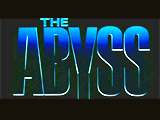

The Abyss (1989), 140 minutes, D: James Cameron
Director James Cameron's expensive but impressive landmark science-fiction adventure film had a pacifist message similar to the one in The Day The Earth Stood Still (1951). It received four Academy Award nominations, and won the Oscar for Best Visual Effects. In the startling, credit-less opening title sequence, the words "THE ABYSS" emerged from the darkness, and then the camera descended down into the letter "Y" into the ocean - there appeared a view of an American, ballistic missile nuclear submarine, the U.S.S. Montana; the experimental submarine was on patrol near the Cayman Trough, a very deep water area, and experienced a momentary loss of power. In early 1994, when the US submarine attempted to follow a fast and highly maneuverable entity (or "bogey") - possibly a provocative alien species, it unexplicably struck an undersea mountainous ridge and quickly sank into the abyss, falling into the deep Caribbean Sea waters (about 25,000 feet down). This was soon after followed by a frighteningly-realistic drowning scene, and a scene of divers surveying the drowned corpses - with facial expressions that mocked death. With a hurricane and the Soviets approaching, the US Navy attempted a rescue and salvage operation, by requesting and demanding help from the crew of an underwater oil-drilling platform known as Deepcore - the prototype of a roving, seabed oil-drilling station. The assignment was to be reluctantly led and conducted by Deepcore's rig foreman Virgil "Bud" Brigman (Ed Harris), and his assertive, estranged wife Dr. Lindsey Brigman (Mary Elizabeth Mastrantonio), Deepcore's designer and project engineer. Both would now be forced to work closely together even though there were involved in a pending divorce. The Deepcore personnel members were also joined by US Navy SEAL commandos, headed by Lt. Hiram Coffey (Michael Biehn), who was leading the effort to untrigger the sunken submarine's cargo of 24 potent, Trident nuclear missile warheads: ("8 M.I.R.V.s per missile - that's a hundred and ninety-two warheads"). It was revealed, as a foreshadowing, that he was susceptible to pressure sickness (known as HPNS - "High Pressure Nervous Syndrome") that was known to drive individuals insane. The film featured many computer-generated images during enigmatic encounters with the alien craft and visits with the watery, luminous abyss-dwelling aliens - known as NTIs (Non-Terrestrial Intelligences), including the revelatory emergence of a glowing purple/pink ship in front of Lindsey -- and her later description of it to "Bud": ("It... it was like a dance of light!"). In the amazing "pseudopod" sequence, a CGI water-based tentacle or tube of water morphed into the faces of Lindsey and Bud. Coffey was intent on destroying the NTIs, and armed a warhead retrieved from the submarine to eliminate the aliens; during Lt. Coffey's two major tense, action sequences after he became delusional and paranoid from the intense pressure, he knife-fought with Bud and engaged in a "chase" scene involving two mini-submersibles that culminated in Coffey's death when he was crushed within his submersible by the pressure, but Bud and Lindsey were stranded in their leaking mini-submersible with only one aqualung. Lindsey made the devastating decision to let Bud use their sub's sole diving suit to swim back to the platform, towing her body behind him in the frigid water. Subsequently, Lindsey drowned (went into deep hypothermia) and Bud was called upon to frantically resuscitate her using a combination of methods: heart-shocks, pounding on her chest, screaming at her, slapping her, crying, and mouth-to-mouth CPR, until she gasped and took a breath. The resuscitation sequence was paralleled by Lindsey's speech to Bud when he decided to engage in a free-fall wearing an experimental diving suit (breathing oxygenated fluid instead of air) - a possible 'one-way' trip to descend into the 2.5 mile deep Abyssal Trench to defuse a nuclear bomb warhead. Lindsey sent heartfelt and reassuring messages that were relayed to him as he descended dangerously into a deep ocean trench to disarm the nuclear warheads on the submarine: ("I know how alone you feel... alone in all that cold blackness... but I'm there in the dark with you. Oh Bud you're not alone...I'm with you. I'll always be with you, Bud, I promise that"). After dismantling the warhead in a tense sequence (he had to guess the wire to be cut), Bud ran out of oxygen, and was encountered by beneficent, angelic-looking NTI's (Non-Terrestrial Intelligences) who rescued him; they took him to their awe-inspiring underwater city and their mothership - in a 2001-ish and/or Close Encounters-like sequence. During his time with the NTIs, Bud was shown TV clips about the destructive nature of human beings with images of war, genocide and aggression - one of the originally deleted scene (restored in the director's cut) was the astonishing "tidal wave" sequence in which both coasts (and an unnamed Russian port and other global locations) were threatened by massive amounts of water (1,000 foot high tidal wave megatsunamis controlled by the NTIs - but then subsided (followed by a warning from the aliens to Bud and all of humanity against war-like aggression); they changed their minds due to Lindsey's compassionate message to Bud: "LOVE YOU WIFE." The film concluded with the rise of the alien ship to the ocean's surface, the saving of the Deepcore crew, and a reunion between Bud and Lindsey after their greeting: ("Hi, Brigman," "Hi, Mrs. Brigman").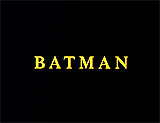



Batman (1989), 126 minutes, D: Tim Burton
See Batman film series.
Tim Burton's noirish, live-action comic-book superhero film was a more dark and menacing version of the campy and humorous 1966-68 Batman TV series and feature film Batman (1966). The ambitious blockbuster hit, the highest-grossing film of the year, featured the title character - the brooding Caped Crusader/Bruce Wayne (Michael Keaton) - a winged vigilante battling crime after his parents' murder. Mobster henchman Jack Napier (the murderer of Bruce Wayne's parents many years earlier) was also transformed after falling into a vat of acidic chemicals, to become the insane and outlandish Joker (a scene-stealing, over-the-top, clownish Jack Nicholson, top-billed). With a grotesque visage on a pure white face (with an impossibly-wide, hideous, perma-grin on his blood-red lips), he personified extreme avarice, anarchy, cruelty, and sick humor. Calling himself the maniacal, insane and clownish Joker and using gadgets as weapons, he vowed to spread a reign of terror over Gotham City against his masked nemesis. [Note: In tribute to Nicholson's inimitable, over-the-top portrayal of the Joker, Heath Ledger reprised the character in The Dark Knight (2008).]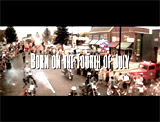


Born on the Fourth of July (1989), 145 minutes, D: Oliver Stone
This biopic and anti-war film was the second of director Oliver Stone's Vietnam War-era trilogy of films, including Platoon (1986) and Heaven & Earth (1993). It was a biography of real-life veteran Ron Kovic (Tom Cruise) - according to its tagline "a story of innocence lost and courage found." Kovic had been paralyzed during the war from a spinal injury, and he barely survived. In his youth, he was a physically fit athlete who had pride in his country, but that disappeared with his debilitating injury. His disillusionment was heightened by time spent in a Bronx veterans' hospital and his troubling reintroduction to society. He became a staunch anti-war and pro-human rights political activist.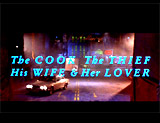



The Cook, the Thief, His Wife & Her Lover (1989, UK/Fr.), 124/98 minutes, D: Peter Greenaway
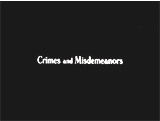

Crimes and Misdemeanors (1989), 107 minutes, D: Woody Allen
Perhaps Woody Allen's darkest, most somber movie, Crimes and Misdemeanors (1989) took a long, provocative, and ultimately downbeat look at morality with its ensemble cast. The tragi-comedy was impressive for its literate and provocative questioning about God's existence and life's meaning. Dual, multi-layered stories about Manhattanites, each composing about one-half of the film, were interwoven together, and interconnected by the character of a mutual friend - a lone holy man and rabbi named Ben (Sam Waterston) who was going blind. The first story dealt with Judah Rosenthal (Martin Landau), a wealthy, law-abiding, well-respected, middle-aged ophthalmologist who was married to Miriam (Claire Bloom) - Rosenthal was successful in nearly every way. However, an enraged and obsessed flight attendant and ex-lover Dolores Paley (Anjelica Huston), his mistress with whom he had been cheating, threatened to divulge the scandal and ruin his life. With this dilemma facing him, Judah was forced to take extreme measures - he contemplated the murder of his mistress by contacting his seldom-seen brother Jack (Jerry Orbach) with Mafia connections. His guilt over her murder forced him to revisit his past and ask basic questions about his own values, the unfairness of life, virtue, 'the eyes of God,' a god-less universe, justice for evil-doing, and unequal punishment of the wicked. Meanwhile, in the lighter-spirited other half of the movie, Cliff Stern (Woody Allen), a dedicated but struggling, serious documentary filmmaker (who was married but in the process of separating from his wife Wendy (Joanna Gleason), Lester's sister), was reluctantly forced to direct a film of his despised rival - his superficial, vain but extremely successful brother-in-law and TV sit-com producer Lester (Alan Alda). Complicating matters, Stern had to compete with Lester over the object of his impossibly-romantic affections - the documentary's attractive production associate Halley Reed (Mia Farrow).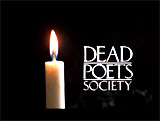

Dead Poets Society (1989), 128 minutes, D: Peter Weir
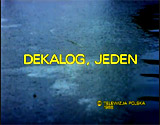

The Decalogue (1989-1990, Pol.) (aka Dekalog: The Ten Commandments), 584 minutes, D: Krzysztof Kieslowski
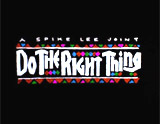

Do the Right Thing (1989), 120 minutes, D: Spike Lee
This was the third (and breakout) feature film for African-American writer/director Spike Lee (who also starred as the pizzeria's delivery boy Mookie), whose resume already included: She's Gotta Have It (1986), and School Daze (1988). Film critics wrongly feared that Lee's film was a call to revolution and would cause and incite similar responses from black urban-dwellers. However, it was an even-handed, complex, unapologetic but still-disturbing social protest work about racism, racial pride, class struggle, intolerance, oppression and violence (based on real-life events). The controversial thought-provoking film provided a raw portrait of explosive conflict and relations between Italian- and African-Americans, Koreans and white law-enforcement in a multi-ethnic Bedford-Stuyvesant neighborhood block (in Brooklyn) during a stifling hot summer day. During the opening credits, hip-hop group Public Enemy performed the film's hard-edged anthem and title rap song, "Fight the Power." The multi-ethnic cast of the film provided three-dimensional characters, and featured on-going commentary by local black DJ Mister Senor Love Daddy (Samuel L. Jackson). Other roles included white Italian-American pizzeria owner Sal (Danny Aiello), and 25 year-old pizza delivery boy Mookie (Spike Lee) and his girlfriend Tina (Rosie Perez). The tensions began to escalate in this slice-of-life film because of a complaint by Mookie's friend - a militant patron named Buggin' Out (Giancarlo Esposito) (and later by boom-box carrying Radio Raheem (Bill Nunn)) that there were no pictures of 'brothers' on the "Wall of Fame" in Sal's restaurant. A boiling point was eventually reached in this street-wise landmark film.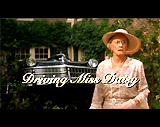


Driving Miss Daisy (1989), 99 minutes, D: Bruce Beresford
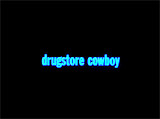



Drugstore Cowboy (1989), 100 minutes, D: Gus Van Sant, Jr.
Director Gus Van Sant's penetrating, post-modern second film, a crime drama and road trip saga, was a risky piece of work - under-appreciated and overlooked, yet it became his breakthrough film. The film was based on the 1990 published autobiographical novel by James Fogle. Set in the year 1971, it followed the aimless lives of four resourceful dropouts cruising in the Pacific Northwest to steal prescription drugs (dilaudid, morphine and cocaine) from various pharmacies and hospitals, while living a dreary communal life. The 26 year-old junkie leader of the pack of dysfunctional teens was Robert "Bob" Hughes (Matt Dillon), accompanied by his addicted wife Dianne Hughes (Kelly Lynch), Bob's best friend Rick (James LeGros) and his teen junkie girlfriend Nadine (Heather Graham). Bob became increasingly desperate when faced with the consequences of drug addiction (a lethal overdose by Nadine) and pressure from police authorities. By the film's conclusion, Bob had entered a methadone treatment program to go straight, split from Dianne who had left him for Rick, and was shot and seriously wounded by another junkie and on a stretcher bound for a hospital to be kept alive - he ironically noted that it had "the fattest pharmacy in town."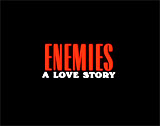


Enemies, A Love Story (1989), 119 minutes, D: Paul Mazursky
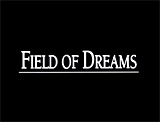

Field of Dreams (1989), 107 minutes, D: Phil Alden Robinson
Just one year after playing catcher "Crash" Davis in Bull Durham (1988), Kevin Costner appeared in this - another baseball-themed film - coupled with the religious themes of faith and redemption. It was adapted from W. P. Kinsella's novel Shoeless Joe. The sports fantasy-drama was almost dreamlike (aided by the mystical score by James Horner). This sentimental, modern classic became a smash hit in its unique depiction of Americana. The Capra-esque film recalled Harvey (1950), a film in which its main character (James Stewart) believed he was befriended by a giant 6-foot rabbit that no one could see. (The 1950 b/w film was seen at one point in the film on TV, to emphasize the connection.) Idealistic 36 year-old Ray Kinsella (Kevin Costner), a transplanted city boy-turned-Iowa corn farmer, heard a ghostly Voice telling him to build a baseball diamond in the middle of his corn field ("If you build it, he will come") - and then another bit of advice - to "ease his pain." His wife Annie (Amy Madigan) and their young daughter Karin (Gaby Hoffmann) were semi-supportive but worried about their finances if he plowed down their crops. No one but those who believed could see the ghostly ballplayers who began to appear. Ray met with various sad and wistful icons, including the ghost of Shoeless Joe Jackson (Ray Liotta) who was banned from baseball for life after the 1919 Black Sox scandal, a disillusioned, reclusive J.D. Salinger-like writer in Boston named Terence Mann (James Earl Jones), and a small-town doctor named Doc "Moonlight" Graham (Burt Lancaster) - a rookie player who years earlier yearned to make it into the major leagues. The film reached its climax with Mann's famous monologue on the place of baseball in American history: "The one constant through all the years, Ray, has been baseball. America has rolled by like an army of steamrollers. It's been erased like a blackboard, rebuilt, and erased again. But baseball has marked the time. This field, this game, is a part of our past, Ray. It reminds us of all that once was good, and that could be again. Oh people will come, Ray. People will most definitely come." By the film's conclusion, he was able to restablish a broken connection with his deceased father John Kinsella (Dwier Brown) through a game of catch on the field he had built.


Glory (1989), 122 minutes, D: Edward Zwick
Director Edward Zwick's historical wartime drama was one of the very best, fact-based Civil war films. The two historical novels on which it was based were 1973's Lay This Laurel by Lincoln Kirstein and 1965's One Gallant Rush by Peter Burchard. Another source was comprised of the letters written by the commander of the 600-man regiment - the centerpiece of the film. It also featured a Grammy-winning, powerful score by James Horner accompanied by The Harlem Boys Choir. The well-received film had five Oscar nominations: Best Art/Set Decoration, and Best Film Editing, with three wins: Best Supporting Actor (Denzel Washington), Best Cinematography (Freddie Francis), and Best Sound Editing. It depicted the overlooked but brave and distinguished participation of all-volunteer, African-American soldiers on the side of the Union in the first all-black 54th Regiment of the Massachusetts Volunteer Infantry (composed of runaway slaves and northern "freemen"). The unit was led by 25-year old white commander, Col. Robert Gould Shaw (Matthew Broderick) who came from a privileged, abolitionistic family in Boston. The film focused on the hard training of the troops before battle to earn credibility with prejudiced military authorities, and their actual demonstration of courage, bravery, sacrifice and determination during combat. The movie climaxed with their final, suicidal assault in mid-July 1863 on the impregnable Fort Wagner near Charleston, South Carolina - it failed but ultimately turned the tide of the war. Strong supporting roles were from bitter, ex-slave recruit Pvt. Trip (Denzel Washington in a star-making role), born leader Sgt. Major John Rawlins (Morgan Freeman who transcended typical Hollywood stereotypes about African-Americans with his distinctive performance) and Major Cabot Forbes (Cary Elwes).


Henry V (1989, UK), 138 minutes, D: Kenneth Branagh
Director/screenwriter Kenneth Branagh's adaptation of William Shakespeare's timeless, epic play Henry V - was his debut film as both screenwriter and director. From three Academy Award nominations (including Best Actor and Best Director), it won the Oscar for Best Costume Design. The play was chiefly about royal responsibility, war and its effects. The nature of the film was deeply affected by the historical context in which it was created -- it debuted during a post-Vietnam era when there was great cynicism about war. Branagh's revisionistic film was dramatic, grandiose, passionate and darkly serious. It told about the title character - young, 15th century British King Henry V, including his differences with King Charles VI of France (Paul Scofield), his invasion of France in 1415 A.D., and his victory at the crucial and bloody Battle of Agincourt against a larger French force. Henry took as his bride French princess Katherine of Valois (Emma Thompson, Branagh's wife at the time), the daughter of Charles VI. The film's highlights were -- Henry V's pre-battle speech to his troops at the siege of Harfleur, from Act III, Scene 1, beginning with the stirring line: "Once more unto the breach, dear friends, once more; or close the wall up with our English dead," and his St. Crispin's Day address to his battle-weary men, from Act IV, Scene 3, "We few, we happy few, we band of brothers. For he today that sheds his blood with me shall be my brother."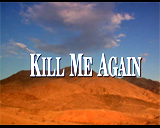



Kill Me Again (1989), 94 minutes, D: John Dahl
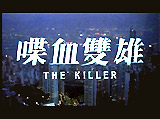


The Killer (1989, HK) (aka Die Xuet Shuang Xiong), 111 minutes, D: John Woo
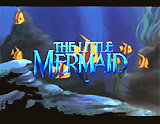

The Little Mermaid (1989), 83 minutes, D: Disney Studio



Music Box (1989), 124 minutes, D: Costa-Gavras
This dramatic courtroom thriller was taglined: "As a lawyer all she wanted was the truth. As a daughter all she wanted was his innocence. How well do you really know your father?" Hungarian-American immigrant Michael J. Laszlo (Armin Mueller-Stahl), an anti-Communist, was threatened with having his US citizenship revoked, and being deported to Hungary to stand trial for war crimes. Laszlo insisted that it was a case of mistaken identity. His daughter Ann Talbot (Jessica Lange), a tough Chicago defense attorney, unwisely decided to defend her father in the case. One of her motivations was her son Mikey's (Luke Haas) deep love for his grandfather. Talbot's prepared defense was that the communist Budapest government (and its AVO secret police) had fabricated the allegations due to Laszlo's fanatical anti-Communist feelings. The US federal government's position, argued by prosecutor Jack Burke (Frederic Forrest), was that Laszlo had falsified his original citizenship application by failing to disclose his name "Mishka" - and his leadership and association with the terrorist organization, political party and death squad known as Arrow Cross that had brutally persecuted and murdered scores of Hungarian Jews. The presiding judge was Judge Irwin Silver (James Zagel), a Jew. During the denaturalization trial in a Chicago federal court, evidence was presented showing a copy of young Laszlo's Arrow Cross ID card with his name "Laszlo Miklos." The picture matched his visa application. Talbot argued that any evidence was forged or inauthentic. However, there were surviving witnesses who testified to 'Mishka's' atrocities. During cross-examination, Ann was able to cast some doubt on some of the prosecution's charges. During the trial, the judge and opposing lawyers traveled to Budapest, where Ann planned to speak to a witness who couldn't travel, and was handed some documents by a member of the secret police. During the witness' testimony, Ann discredited him - she dismissed the accusations and documents by claiming that the witness had identified three completely different individuals as 'Mishka.' Judge Silver promptly dismissed the government's case. Before leaving Europe, Ann visited Melinda Zoldan (Elżbieta Czyżewska), the sister of Tibor Zoldan, one of Laszlo's fellow Hungarians (and a member of the Arrow Cross organization!) to whom he had written numerous checks. In Zoldan's wallet was a ticket to a pawn shop for a music box. When she redeemed the pawn ticket in Chicago, she found proof of her father's guilt. The pretty music box contained B/W photographs of her father involved in atrocities and war crimes. Ann denounced her deceitful father - threatening to never have Mikey or herself see him again. She sent the damning photographs to prosecutor Burke, who publicized them in the press.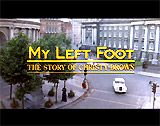


My Left Foot (1989, UK), 98 minutes, D: Jim Sheridan


Roger & Me (1989), 91 minutes, D: Michael Moore
One of director/star Michael Moore's earliest interview-documentaries was this sleeper hit - a satirical and hilarious take on the fate of Flint, Michigan (Moore's hometown!). Policies of the GM chairman Roger Smith, judged as a symbol of corporate wealth and greed, had resulted in numerous plant closures, unemployment, unrest, and urban crime and blight. Although Moore's quest to track down and speak directly to the CEO was unsuccessful, his wanderings brought him into enlightening contact with displaced autoworkers, local law enforcement and political officials, celebrities (Pat Boone and Anita Bryant), and even President Reagan.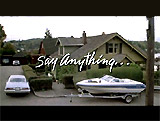


Say Anything... (1989), 100 minutes, D: Cameron Crowe
Cameron Crowe's fresh and sweet HS teen love story (his directorial debut film) was far and away one of the best of its type, with added intelligent resonance about coming-of-age, facing difficult challenges, and making choices. Realistic empathic performances abound: A charming yet average, recently-graduated jock-teen Lloyd Dobler (John Cusack) was determinedly interested in Diane Court (Ione Skye), a brainy and beautiful biochemistry student. However, she was being overprotected by her single father James Court (John Mahoney) who was also contending with troubling allegations of IRS tax violations. Its most memorable and iconic image was of a 'boom-box' hoisted over-head by Lloyd to play Peter Gabriel's "In Your Eyes" to Diane in her upstairs bedroom.



sex, lies and videotape (1989), 101 minutes, D: Steven Soderbergh
26 year-old writer/director Steven Soderbergh's independent film (his first feature film) - a low-budget, minimalist, character-driven debut film was the kinky, sharply-acted, and provocative, with suggestive discussions of sexual topics but without nudity or sex scenes. It was written in eight days and filmed over five weeks on a budget of $1.2 million, and became a huge hit at the Sundance Film Festival. The compelling effort also won the prestigious Palme d'Or at the Cannes Film Festival, becoming a catalyst for the 'independent' (non-Hollywood) film movement. There was explicit dialogue in videotaped discussions and revelatory confessions of women in New Orleans talking about their complex sexual experiences. Reclusive drifter Graham Walton (James Spader) called the voyeuristic videotaping a "personal project," serving as a substitute for his own emotion-less, impotent and dispassionate life. Infidelity was revealed between his college-buddy turned yuppie lawyer John Mullany (Peter Gallagher), and the sexually-adventurous bartender sister Cynthia Patrice Bishop (Laura San Giacomo) of his own sexually-repressed, frigid and neglected wife Ann Bishop Mullany (Andie MacDowell). In one of the film's memorable scenes, Ann reversed roles and turned the camcorder on Graham to help him with his "problem."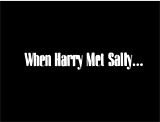



When Harry Met Sally... (1989), 96 minutes, D: Rob Reiner
This witty and likeable, lightweight, old-fashioned romantic comedy was intended to answer the sexual politics question, "Can two friends sleep together and still love each other in the morning?" The main timely premise was whether a man and woman can be friends without sex interfering. Director Rob Reiner directed this smart, modern-day 'screwball comedy' (his fifth film) of the semi-autobiographical tale - it was compiled from the shared recollections of actual romances, and sometimes resembled a sitcom. The engaging, episodic film keenly observed romance, relationships between males and females, friendship and sex. The summer of 1989's 'sleeper' film had a number of startling resemblances to Woody Allen's witty, urban romance Annie Hall (1977) including: the black and white titles and the film's title song "It Had to Be You" (sung by Diane Keaton in Allen's film), direct camera interviews-testimonials, split-screen techniques, the Manhattan backdrop, evocative George Gershwin tunes, obsessive talk about sex and death, and Harry and Sally's first meeting in 1977 - the year the similar film was released. The film's ending paralleled Allen's Manhattan (1979). However, the two films also differed: When Harry Met Sally... illustrated how friends can ultimately realize that they're better as lovers, while Annie Hall showed how lovers may end up better as friends. Its most unforgettable scene was Sally's noisy counterfeit orgasm in a deli, causing the director's mother (one of the witnessing customers) to order: "I'll have what she's having." In the film itself, two long-time acquaintances, often pessimistic, fast-talking and controlling Harry Burns (Billy Crystal) and bubbly Sally Albright (Meg Ryan) grappled with their friend-relationship over a 12-year period (beginning in the spring of 1977 as students when they shared a drive to New York from Chicago, and thoroughly irritated each other along the way), as they grew up and matured. Their love was not "at first sight" but took years to develop as the reluctant two often bumped into each other, reconnected and formed a friendship. The leads' best friends, Marie (Carrie Fisher) and Jess (Bruno Kirby), helped Harry's and Sally's friendship to evolve, and actually fell in love and got married themselves. A turning point for Harry and Sally was when they slept together one night, but then Harry was subsequently unable to express commitment, leading to their breakup. In the happy ending finale, on New Years' Eve, the two realized that they were meant for each other.